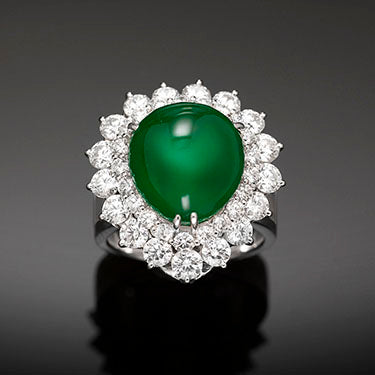[callout]"Gold is estimable; but Jade is priceless."
-Chinese proverb[/callout]

Imperial Jadeite “Sugar Loaf” Cabochon Ring
Shrouded behind a veil of verdant mystery for centuries, the brilliance of jadeite inspired fascinating legends of desire. One such tale tells of a Chinese emperor who offered fifteen cities for a jadeite carving so small that it fit in the palm of his hand.
Today, Imperial jadeite is ranked as one of the rarest minerals on earth. Jewelry crafted of this precious stone can fetch amazing dollar amounts. A Christie's auction in Hong Kong of a jadeite necklace comprising 27 beads of approximately 15mm in size brought in $9.3 million dollars in November of 1997.

The beautifully carved and luminous Jadeite bat is the focal point of this amazing peach pin. The peach represents health and longevity, while the bat brings with it good luck, fertility and extra long life.
But what exactly makes jadeite so special? Why is it called jadeite and not just jade? This article dives into the world of Jade and uncovers the true history of this magnificent gem.
The Ancient History of Jade
For over 7,000 years, jadeite has been chosen by many cultures to create the most precious pieces of jewelry. It can be found in Myanmar, Guatemala, Mexico and California, but the most rare and most beautiful is the Imperial jadeite found exclusively in Myanmar (formerly Burma).
Dating back to prehistoric times, Jade had always been a highly prized material. Not only was it crafted into circular and tubular shapes for simple ornaments, it was also worked into tools and weapons due to its toughness and durability. Once Jade gained higher prestige among royalty and elitists, the stone was transformed into jewelry, carvings, and decorations for imperial families. In 3,000 BC the Jadestone became recognized as “yu,” the royal gem throughout China.
The impact of Jade on Chinese culture was so significant that the highest members of society were even buried in suits made out of the gemstone. Because of its historical and spiritual significance in Chinese culture, jewelry, ornaments, and weapons made of imperial Jade are extremely valuable.
Shop Jadeite: Browse our renowned collection of Jade here »
The Difference Between Nephrite and Jadeite
Although it may seem like all forms of jade are the same, there are differences between the two forms of Jade. Jade refers to both nephrite and jadeite. Both Nephrite and Jadeite are highly prized gems, however, Jadeite is rarer (and therefore more expensive.)
For over 2,000 years, the stone known exclusively as "jade" in China was actually nephrite. The terms became intertwined as Europeans noticed certain similarities between the two, and began referring to both as jade. Nephrite jade has a more milky appearance and can be scratched by a knife blade. In today’s market, both Jadeite and Nephrite are valued for their individual characteristics and each individual piece is completely unique.
The majority of green Jadeite was found in Burma and was later traded and sold throughout China and eventually across the world. Jadeite Jade possesses a rich emerald green coloration, a translucent, almost glowing quality, and is harder than steel. After discovery, the Burmese Jadeite quickly became one of the most sought-after stones of the 14th century.
Qualities of Imperial Jadeite
The finest examples of Imperial jadeite are graded upon three qualities that transform it from a beautiful stone to an incredibly rare gem: color, translucency and texture. The most desirable examples of natural Imperial jadeite display an even, vivid green color, often compared to that of an emerald as seen in this breathtaking pair of jadeite and diamond earrings. The bright emerald coloring is the most popular, however, Jadeite can also come in red, brown, orange, black, yellow, grey and lavender coloring.
When it comes to texture, most people are looking for a soft and smooth surface. However, it is also important to note that Jadeite can come in a variety of textures including medium to fine depending on the structure of the stone.
Lastly, the transparency of the Jadeite will vary from one to another. Some gems are opaque allowing little light to come through while others are almost fully transparent. Fine Jadeite stones that are almost completely transparent will have a subtle glow and are highly desirable.
Just like with diamond jewelry, the cut of the stone will also influence its value. All in all, the stone should appear glassy in translucency and have a fine texture that allows light to pass through it effortlessly without sacrificing the brilliance of the color.
Though many things have changed in the world since green jadeite became known more than seven millennia ago, the awe and desire this viridescent wonder of nature evokes is as powerful today as ever before.
Shop The Article: Browse our collection of Imperial Jade here »






